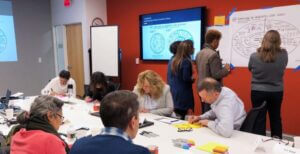
A well-crafted strategy is about making intentional choices that position organizations for long-term success. A thoughtful approach not only defines where you’re going but also lays out a clear, adaptive path forward that everyone within the organization can understand. Great strategy goes beyond planning—it’s about centering people, creating alignment across the organization, and developing plans that are resilient and responsive. Here’s how organizations can bring strategic alignment and planning into focus.
A successful strategic plan is one that engages stakeholders, translates complexity into clarity, and provides actionable steps forward. Based on our insights from diverse industries, high-impact strategies tend to include these foundational elements:
Strategic alignment and planning aren’t one-size-fits-all. Every organization’s journey is unique, requiring a tailored approach that meets specific needs—whether through targeted prioritization, collaborative strategy development, or a comprehensive, multi-year planning effort.
A strategy succeeds when it’s embraced by the people who carry it forward. And the best strategies are developed with an eye toward activation—doing so will transform the strategy from ideas on paper into actions that drive progress. Use the following strategic planning process framework to establish the foundation needed for successful activation:
1. Assess: Begin with data collection, interviews, and a thorough assessment to establish a baseline understanding. This stage reveals valuable insights and identifies critical factors needed to move forward.
2. Envision: Strategy gains momentum when leaders collaborate to define a shared vision for the future. Through structured visioning sessions, organizations can establish a clear, mid-term outcome that anchors the strategic plan.
3. Align on Priorities: With a vision in place, it’s time to set priorities, create a change narrative, and establish metrics for success. Tools like strategic dashboards can provide ongoing visibility into progress and impact.
4. Activate: Effective activation includes planning for communication, ensuring teams understand and support the strategy, and assessing readiness for change. This is the point at which strategy transitions into action.

How to Elevate People-Centered Strategy at Your Organization
A strategic approach that resonates with people at all levels creates alignment that is both authentic and impactful. Organizations can elevate human-centered strategy through the following methods:
Collaborative Workshops: Bringing stakeholders together to co-create clarity accelerates alignment and enhances buy-in. Visual tools, design sprints, and collaborative frameworks are effective for simplifying complex ideas and building consensus.
Narrative and Visualization: Translating strategy into compelling, accessible visuals and stories makes it easier for everyone to connect with the purpose behind the plan. Design assets and storytelling transform strategy from abstract ideas into inspiring, relatable messages.
Develop Buy-In from the Start: Strategic plans reach their full potential only when followed by actionable, continuous alignment. Ensuring there’s support for ongoing execution and a willingness to adapt over time helps keep momentum alive.
Consider an example from the healthcare sector, where a major professional association faced declining membership and financial strain. With new leadership in place, the organization sought a strategy that would stabilize its operations and enable growth. By conducting a thorough assessment, gathering input from stakeholders, and developing a comprehensive four-year plan, the organization transformed its trajectory. The results were clear: a 33% increase in revenue over three years, improved engagement, and renewed alignment around a shared vision. With a thoughtful strategy and a commitment to people-driven activation, the association strengthened its role and impact in the healthcare industry.
A successful strategy is one that people believe in and are motivated to carry forward. When leaders commit to creating clear, inclusive, and adaptable strategies, they set the stage for lasting impact. By centering on people and creating alignment across every level, organizations can build a resilient foundation for sustainable growth and transformation—driven by strategy, supported by people.
Your team has the perspective to bring your strategy to life through people-centered alignment and practical, actionable planning. Accelerate those results with our skilled consultants, who can ensure you make the most of your strategic planning investments. Whether you’re refining your vision, setting priorities, or driving change, we’re here to help your strategy make an impact. Fill out the form below to chat, and someone from our team will get back with you.